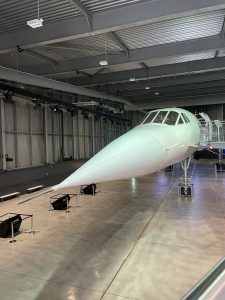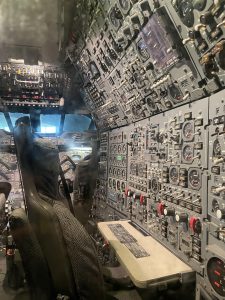Day 6 at LIYSF! Today I visited Airbus UK and Aerospace Bristol. Unfortunately, Airbus didn’t allow photos in any of their facilities but I’ll do my best to describe what I saw!
Airbus has 25 locations across the UK and the location we visited today specializes in fuel systems, landing gear, and wings. Our tour started by learning about how they test their fuel systems using simulated failures. I was surprised by how computationally heavy this facility was, with stacks of computers and technology all throughout.
After learning about fuel systems, we had the opportunity to watch real-time landing gear test sequences for the A350 1000 aircraft in a huge warehouse. The landing gear came down from a huge platform, stay for a moment, and go back up. This process repeated a number of times and the goal was to test where the system will fail. Seeing the landing gear for this aircraft, which weighs approximately 60, 000 kg, was spectacular! It was so precise and all the machinery moved with such ease, it was so special to experience. We then put on our hardhats and safety vests and had the chance to do a walk around of the landing gear for the A350 900 aircraft (same as the A350 1000 except the 900 has 4 wheels instead of 6).
After learning about landing gear, we went on small tours of their research facility. My favourite part was seeing the various scales at which they do things. For example, we started by looking at a high-capacity testing facility that can supply 25 Mega Newtons of force on an object that it’s testing! It was a massive apparatus, about 13m in height. Right after, we checked out their additive layer manufacturing plant which is basically 3D printing with microns of aluminum. It was really interesting how a field like aerospace does research in both stress-testing massive objects to building up parts from micron thick layers of metal! The coolest lab for me to see (as a physics enthusiast) was their electron microscope. When something is under this type of microscope, you can determine the constituent elements that make it up. It does this by bombarding the material with electrons. This excites the electrons inside the material which causes them to gain energy. As the electrons “settle down” and go back down in energy levels, they release a photon with a specific energy. By measuring how energetic the released photon is, you can determine the chemical composition! I found this fascinating.
The next visit was to Aerospace Bristol, a museum with a super special feature: a British Airways Concorde! These jets, only 20 made in the world, flew at supersonic speeds and could go from Heathrow to New York in around 3 hours. They could only seat 100 people and tickets were about £8000 in the 1990’s! It was amazing to see such a powerful plane in person.
I enjoyed my visits to Airbus and Aerospace Bristol today and I’m looking forward to our specialist lectures tomorrow!
~Annabelle



